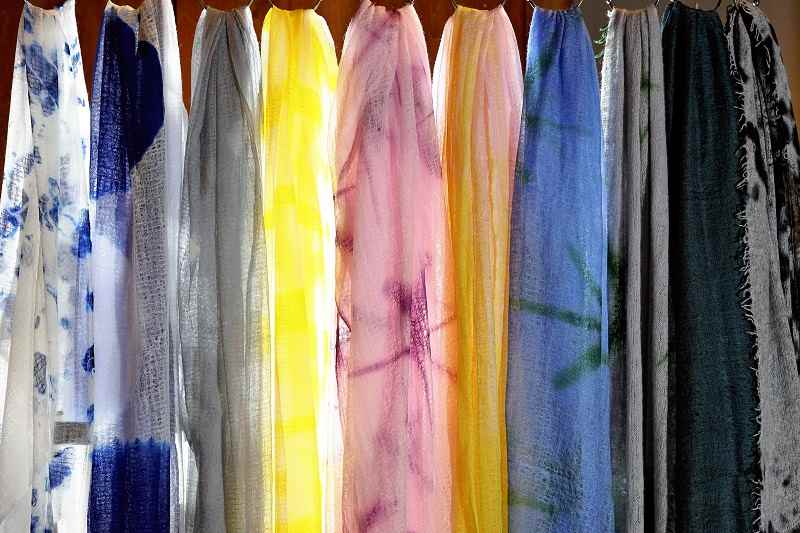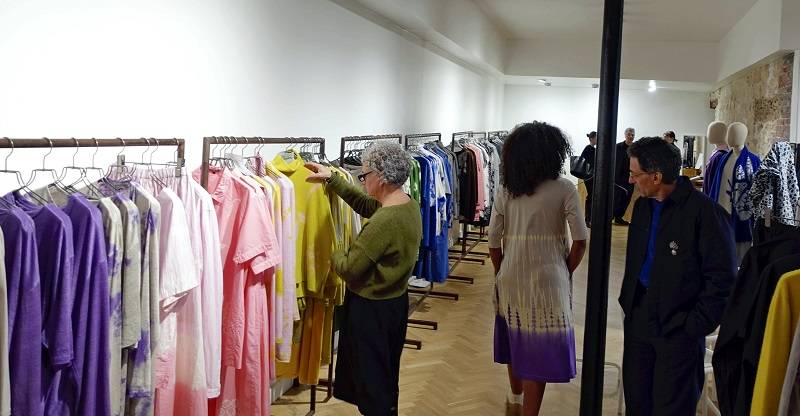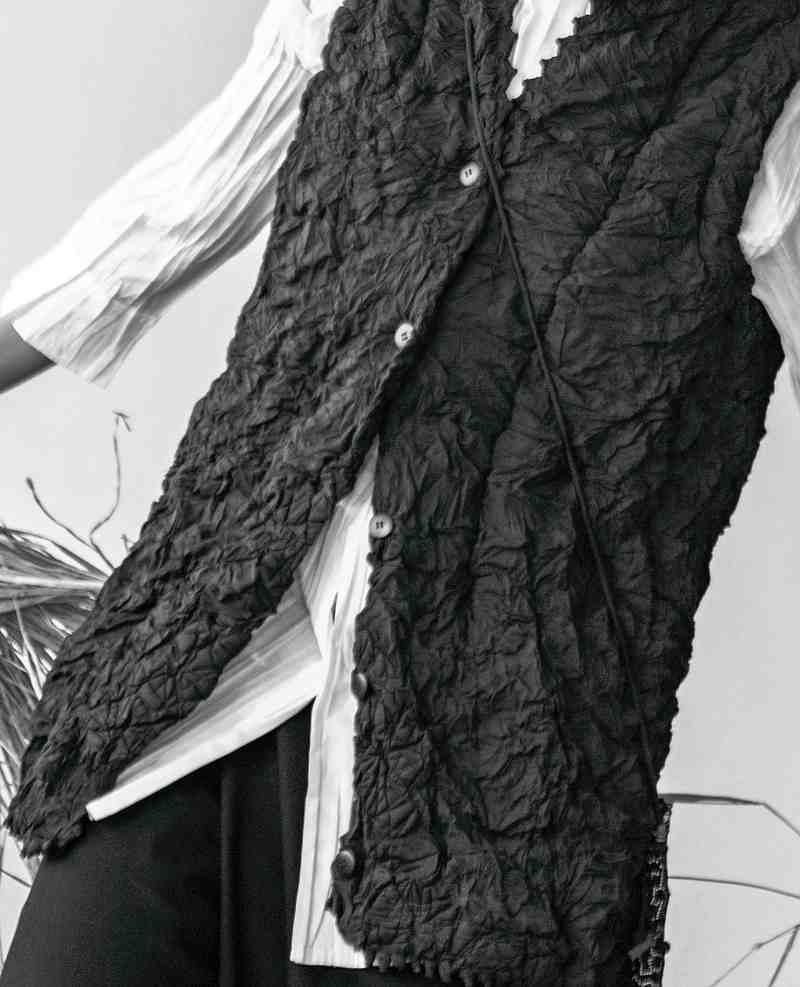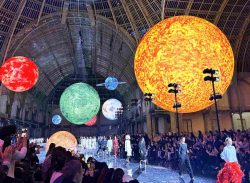
Stoles in various colors designed by suzusan
16:47 JST, December 1, 2022
Arimatsu-Narumi shibori, a traditional tie-dyeing technique practiced for more than 400 years, has been given new life through modern designs.
A driving force behind the trend is suzusan Co., which manufactures and sells Arimatsu-Narumi shibori fabrics in Nagoya. The company has been attracting attention in Japan and overseas for its one-of-a-kind clothes and stylish interior goods made with original fabric designs tie-dyed with skilled, traditional craftsmanship.
I attended a show at which the company introduced its spring/summer 2023 collection in central Paris in late September.
Cute plant motifs such as flowers and buds are added to traditional patterns such as snowflakes and vertical stripes. I was impressed with the colorful stoles and sweaters that have the characteristics of Arimatsu-Narumi shibori.
Many buyers from all over the world, mainly from other parts of Europe, were eagerly assessing the items and picking them up.
“An old technique is arranged in a modern way. It’s so interesting,” said Andreas Murkudis, who owns a clothing and accessories store in Berlin.
The CEO of suzusan, Hiroyuki Murase said, “Our goal is to create products for people regardless of country, gender and era to enjoy the traditional technique in a fashionable and casual way.”

Hiroyuki Murase during an interview. “I want to make traditional crafts a part of people’s everyday lives.”
Arimatsu-Narumi shibori originated in Nagoya and is designated a national traditional craft. Craftspeople use their own individual tie-dyeing methods, all producing beautiful colors and a wide variety of patterns.
As there was a cotton production area nearby, the technique was widely used to dye cotton cloth to be made into yukata summer kimonos and tenugui hand towels. The business, however, has been declining due to changing lifestyles and other factors, resulting in a decrease in the number of methods from more than 100 at its peak to about 70 today.
Murase is the fifth-generation head of a family that has long manufactured Arimatsu-Narumi shibori products.
He established suzusan in 2008 out of concern over the dwindling industry, while living in Germany.
He said: “I felt its designs were interesting when I saw them objectively from overseas. I wanted to preserve the technique.”

Sweaters by suzusan
Suzusan products are planned and designed by Murase in Germany and then made by craftspeople at an atelier in Nagoya. Departing from the stereotype that the shibori technique is only for cotton yukata, polyester, cashmere and other materials are also used.
In addition to fashion items, the company also makes blankets, tablecloths and other interior items, which have been well received in Europe and the United States.

A show by suzusan is held in Paris to coincide with Paris Fashion Week.
The company has also supplied fabrics with shibori motifs to famous brands participating in Paris Fashion Week.
Currently, the company does business with about 100 stores in 23 countries. Overseas sales account for 85% of the company’s total sales.
In recent years, the company has also been expanding sales channels in Japan following the popularity of its products overseas.
“In an age when everything can be made quickly and accurately, people may rather be attracted to the warmth and value of our products, which take a lot of time and labor to make and may not have a smooth and uniform finish,” Murase said. “I would be happy if people rate our brand highly and it contributes to the technique being handed down.”
Fashion brands use ideas, designs
Some other fashion brands also use Arimatsu-Narumi shibori ideas and designs in their work.
HaaT, an Issey Miyake brand, uses kukuri to create an original fabric texture. Kukuri is a method of binding cloth with string during the dyeing process to create patterns.

A vest by HaaT with a texture created using the kukuri method
The brand has created a shape memory fabric that has an uneven surface created with the kukuri method, with the cooperation of a company that has a history of about 400 years. The fabric is made into vests, shirts and other items.
“They are unique products that use a texture created by handwork as a design,” a person in charge of the brand said.
For spring 2023, fashion label Mame Kurogouchi, a brand by designer Maiko Kurogouchi who regularly participates in Paris Fashion Week, dyed the sleeves and other parts of a dress in gradations of vermillion, inspired by the red-crowned crane.
"Culture" POPULAR ARTICLE
-

Van Cleef & Arpels Dazzles with Art Deco Artisanry at Tokyo Exhibit
-

Disney’s ‘Twisted-Wonderland’ Animated Series Puts Villains in Spotlight: New Show Features School Inspired by Classic Disney Films
-

Japan Plans to Distribute Manga Overseas Via New Platform
-

Ayumi Hamasaki’s Shanghai Concert Canceled Day Before Schedule as Part of Beijing Backlash
-

‘The World Masterpiece Theater Series’ Celebrates 50 Years; Animator Looks Back on Creating Anime Classics
JN ACCESS RANKING
-

Keidanren Chairman Yoshinobu Tsutsui Visits Kashiwazaki-Kariwa Nuclear Power Plant; Inspects New Emergency Safety System
-

Imports of Rare Earths from China Facing Delays, May Be Caused by Deterioration of Japan-China Relations
-

University of Tokyo Professor Discusses Japanese Economic Security in Interview Ahead of Forum
-

Japan Pulls out of Vietnam Nuclear Project, Complicating Hanoi’s Power Plans
-

Govt Aims to Expand NISA Program Lineup, Abolish Age Restriction























